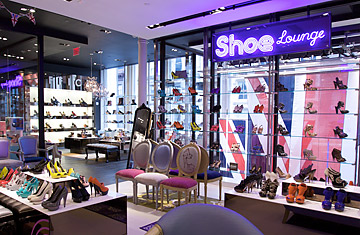
New York City's Topshop, set to open on April 2
Not since the opening of Fiorucci on East 59th Street in the 1970s or Reminiscence on MacDougal Street in the 1980s has a fast-fashion retail brand made such a splash in Manhattan. On Thursday morning the model Kate Moss will join Arcadia Group chairman Sir Philip Green to cut the ribbon on British retail chain Topshop's long-awaited U.S. debut, at Broadway and Broome Street in SoHo. Originally scheduled to hit the Big Apple last fall, the delayed flagship opening comes at a time when other relatively inexpensive fashion brands like H&M and Zara are reporting declining sales figures.
But Green is confident that his chain has the fashion horsepower and merchandising excitement to reel in customers with skinny wallets — and keep them coming back to buy more. "I'm not in the doom camp," said Green in an interview with TIME during New York Fashion Week in February. "We're a $5 billion company, and this is a long-term game. No point in coming here for a walk in the park. We have the right product for this time." (See the top 10 fashion moments of 2008.)
Indeed, from Union Jack jackets to platform sandals and Liberty printed chiffon gowns, the mix of Topshop's trend-driven merchandise can appeal to a broad selection of consumers. The price is also right: Topshop's coveted Baxter jeans are $80, and the average shoe price is about $100. The brand's Oxford Circus flagship store in London — which, at 90,000 sq. ft., is one of the biggest fashion retail spaces in the world, is a favorite pit stop for celebs like Chloë Sevigny, Keira Knightley and Kirsten Dunst. In New York City, Green and his team of 17 designers plan to stock the 25,000-sq.-ft. retail space with 200 to 300 new styles every two weeks. That's a superspeedy rotation given the fact that most U.S. fast-fashion companies restock on a six- to 10-week schedule, while European competitors like H&M and Zara average three weeks.
With the opening of its first outposts in the U.S. and Japan, the 45-year-old Topshop chain now has a presence in 31 countries — with 2,400 stores worldwide, 300 of them in the U.K. — and expansion into three or four more countries is under discussion. Although nothing is confirmed, Green hopes the New York City flagship will be the first of perhaps a dozen stores in the U.S. "I've studied America for a while," he said confidently. "We'll get some things right and some wrong." (See 10 things to do in New York City.)
Topshop's menswear label, Topman, which makes up about a third of the business, will be housed in the basement level of the Manhattan store, while the latest women's trends will be featured on the ground floor along with a DJ booth. The second floor is reserved for Moss's line and Topshop's denim brand, MOTO, as well as collaborations with British designers like Jonathan Saunders, Marios Schwab and Preen. In late April, Topshop will introduce another collaboration with Biba owner and '60s fashion icon Barbara Hulanicki. The third floor will house shoes, accessories and lingerie.
What Green, who was knighted in 2006 for his contributions to the retail business, is hoping will set the fast-fashion chain apart from the competition will be the daily updated merchandise, the high-fashion quotient and the customer service, which includes free personal shoppers. Customers can call ahead for an appointment with a "style adviser" in the store or have a selection of up-to-the-minute merchandise brought to their home for free. Not too shabby, but the question remains: Will London street style play on Broadway?
